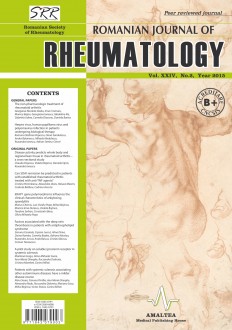SELECT ISSUE

Indexed

| |

|
|
|
| |
|
|
|

|
|
|
|
|
|
| |
|
|
HIGHLIGHTS
National Awards “Science and Research”
NEW! RJR has announced the annually National Award for "Science and Research" for the best scientific articles published throughout the year in the official journal.
Read the Recommendations for the Conduct, Reporting, Editing, and Publication of Scholarly work in Medical Journals.
The published medical research literature is a global public good. Medical journal editors have a social responsibility to promote global health by publishing, whenever possible, research that furthers health worldwide.
A PILOT STUDY ON SOLUBLE (PRO)RENIN RECEPTOR IN SYSTEMIC SCLEROSIS
Marilena Gorga, Alina-Mihaela Soare, Ana-Maria Gherghe, Rucsandra Dobrota, Cristina Mambet and Carina Mihai
ABSTRACT
Background. Wnt signaling is involved in fibrosis, but the mechanisms of cross-talk with other pathways, like TGF-β, are not fully understood. (Pro)renin receptor (PRR) functions as an accessory protein to a V-ATP-ase responsible for acidic pH maintenance in intracellular compartments, and recent data indicate that PRR could be a regulator of Wnt signaling. A circulating fragment (sPRR) is generated by enzymatic cleavage of the extracellular domain and can be quantified in plasma, serum and urine.
Objectives. This is a pilot study, to explore the serum concentrations of the soluble (pro)renin receptor (sPRR) in patients with systemic sclerosis (SSc).
Patients and methods. Serum samples from 29 subjects with a confirmed diagnosis of SSc have been tested using an ELISA method. Clinical and laboratory parameters have been analysed for associations with sPRR serum levels.
Results and conclusion. Serum levels of sPRR were higher in patients with a history of digital ulcers (p 0.041, Mann-Whitney U-test) and those with digital pitting scars (p 0.037, Mann-Whitney U-test). Serum levels of sPRR correlated with serum creatinine (r 0.424, Spearman test), in line with previously reported data. Our results indicate the need for a larger study to assess the sPRR changes in patients with SSc, including more cases with severe disease and excluding a possible impact of angiotensin-receptor blockers.
Keywords: systemic sclerosis, scleroderma, soluble (pro)renin receptor, renin-angiotensin system
